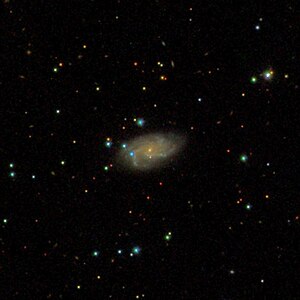NGC 2405
| Galaxy NGC 2405 |
|
|---|---|

|
|
| SDSS recording | |
| AladinLite | |
| Constellation | Twins |
|
Position equinox : J2000.0 , epoch : J2000.0 |
|
| Right ascension | 07 h 32 m 14.0 s |
| declination | + 25 ° 54 ′ 23 ″ |
| Appearance | |
| Morphological type | S. |
| Brightness (visual) | 14.1 mag |
| Brightness (B-band) | 14.9 mag |
| Angular expansion | 0.5 ′ × 0.3 ′ |
| Position angle | 105 ° |
| Surface brightness | 11.9 mag / arcmin² |
| Physical data | |
| Redshift | 0.018890 ± 0.000167 |
| Radial velocity | 5663 ± 50 km / s |
|
Stroke distance v rad / H 0 |
(250 ± 18) x 10 6 ly (76.8 ± 5.4) Mpc |
| diameter | 35,000 ly |
| history | |
| discovery | Albert Marth |
| Discovery date | November 7, 1864 |
| Catalog names | |
| NGC 2405 • PGC 21224 • CGCG 117-051a • MCG + 04-18-026 • 2MASX J07321398 + 2554228 • VV 643 • | |
NGC 2405 is a spiral galaxy of Hubble type Sc in the constellation Gemini on the ecliptic . It is around 250 million light years away from the Milky Way and has a diameter of around 35,000 light years .
The type Ib / c supernova SN 2011gh was observed here.
The object was discovered by Albert Marth on November 7, 1864 .
